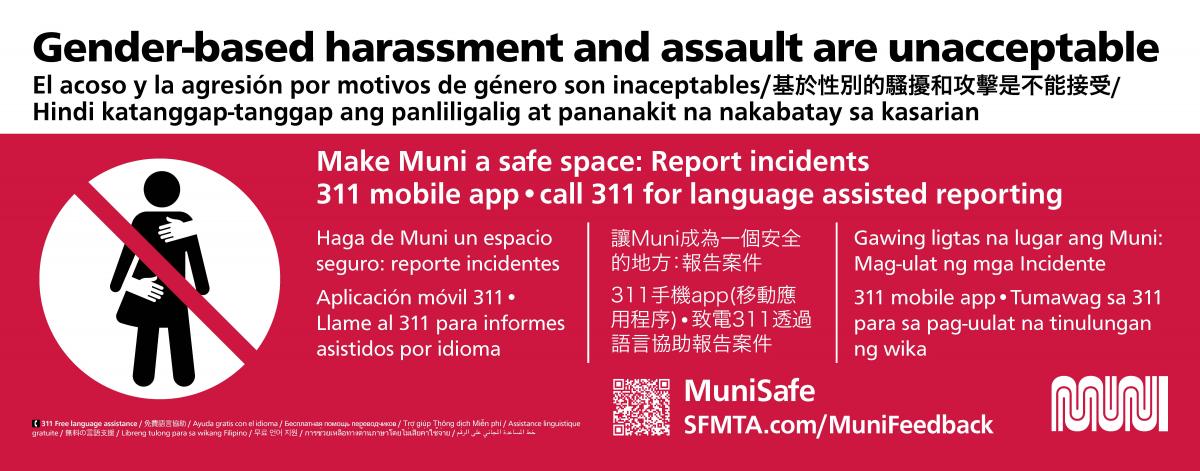By Mariana Maguire
 New Muni “no harassment” symbol
New Muni “no harassment” symbol
The safety of our customers and staff is a top priority for the SFMTA. That is why we are launching MuniSafe – a campaign to increase reporting of gender-based harassment through recently expanded incident reporting options.
If you experience or witness an incident, help us make MuniSafe by reporting it using the Muni Feedback form at SFMTA.com/MuniFeedback, the 311 mobile app or by calling 311.
Non-English speakers should call 311 for language-assisted reporting.
Gender-based harassment takes many forms, affects many people and is absolutely not tolerated on Muni. Survivors should report incidents to the San Francisco Police Department if they feel comfortable doing so. By also reporting incidents directly to the SFMTA, you will help us track events that occur in our system so we can build better safety responses and direct resources to reduce gender-based harassment.
 New car cards that will be installed soon in vehicles system-wide with information about gender-based harassment reporting.
New car cards that will be installed soon in vehicles system-wide with information about gender-based harassment reporting.
Use the Muni Feedback Form at SFMTA.com/MuniFeedback

People should use the Muni Feedback form to report incidents at SFMTA.com/MuniFeedback. Under “Type of Feedback,” select “Complaint,” related to “Muni Service” to access the “Safety and security” topic and the specific topic of “Gender-based harassment.” You have the option to remain anonymous, or to request a follow up.
Your reports made on the form or by contacting 311 go directly to the SFMTA’s Security and Investigations Division. Information is confidential, but descriptions of incidents and behaviors may be shared with the San Francisco Police Department as necessary to support investigation and improve Muni safety.
Our staff will use the information provided in the report to internally investigate the incident, support the survivor and cooperate with law enforcement as needed. Staff will also analyze data from reports to identify and track trends and develop better safety approaches.
Personal Safety and Bystander Tips
- Always stay alert and aware of your surroundings.
- When traveling late at night or alone, sit close to the operator.
- If someone is making you feel uncomfortable, move to a different part of the vehicle.
- Ask for bystander assistance or call the operator for assistance when necessary.
- If you see someone in a vulnerable situation or witness a possible incident, ask the individual if they are ok or need assistance. Offer to stay nearby.
The MuniSafe campaign is a multi-functional effort led by SFMTA’s Security Division to improve safety systems, processes and outcomes. SFMTA’s Safety Equity Initiative, announced in April 2022, is an integral part of the MuniSafe campaign. Learn more at SFMTA.com/SafetyEquity. If you have questions about this initiative, please email MuniSafe@SFMTA.com.
Published August 31, 2022 at 01:06AM
https://ift.tt/FkpvdUK
Nhận xét
Đăng nhận xét